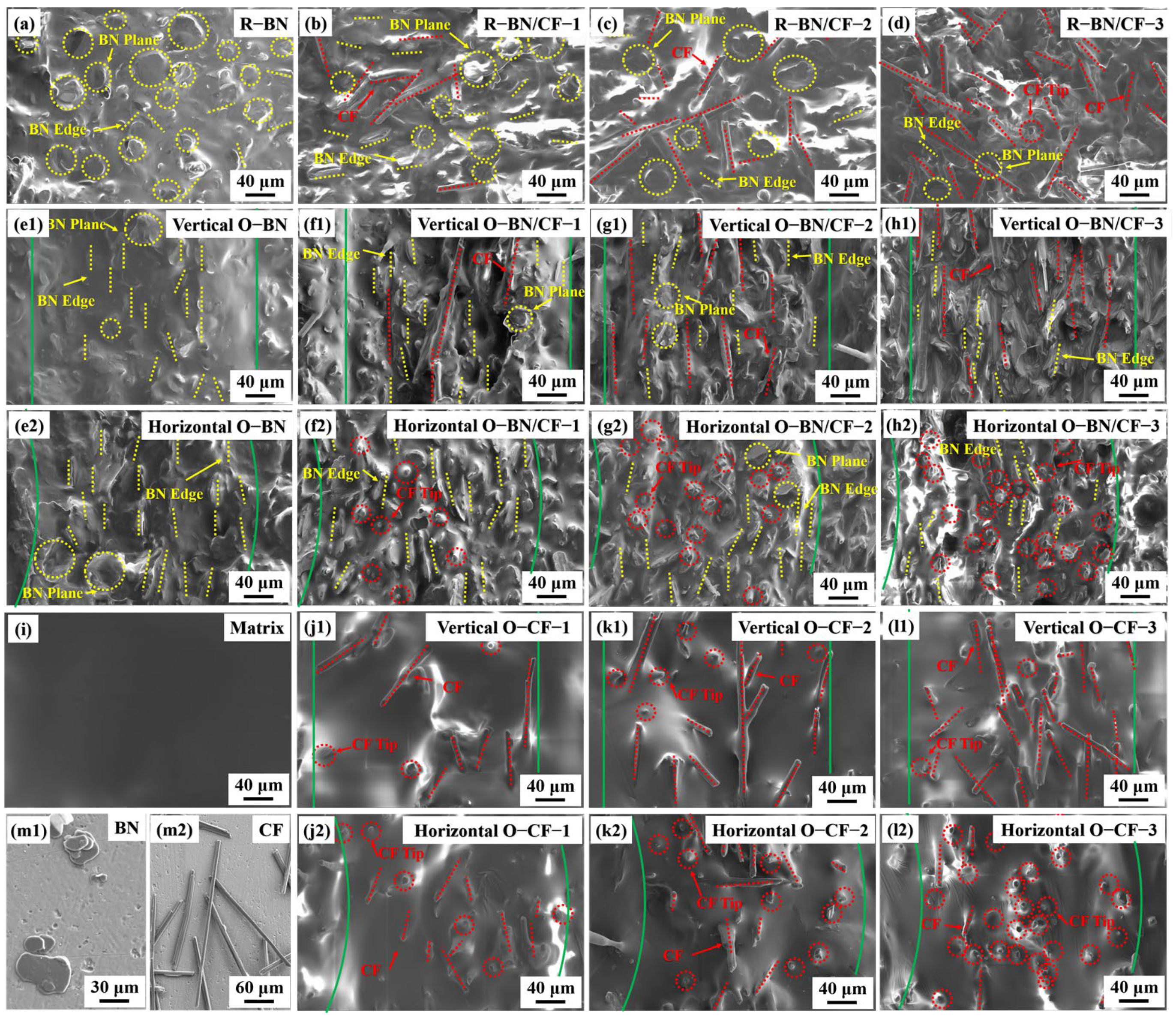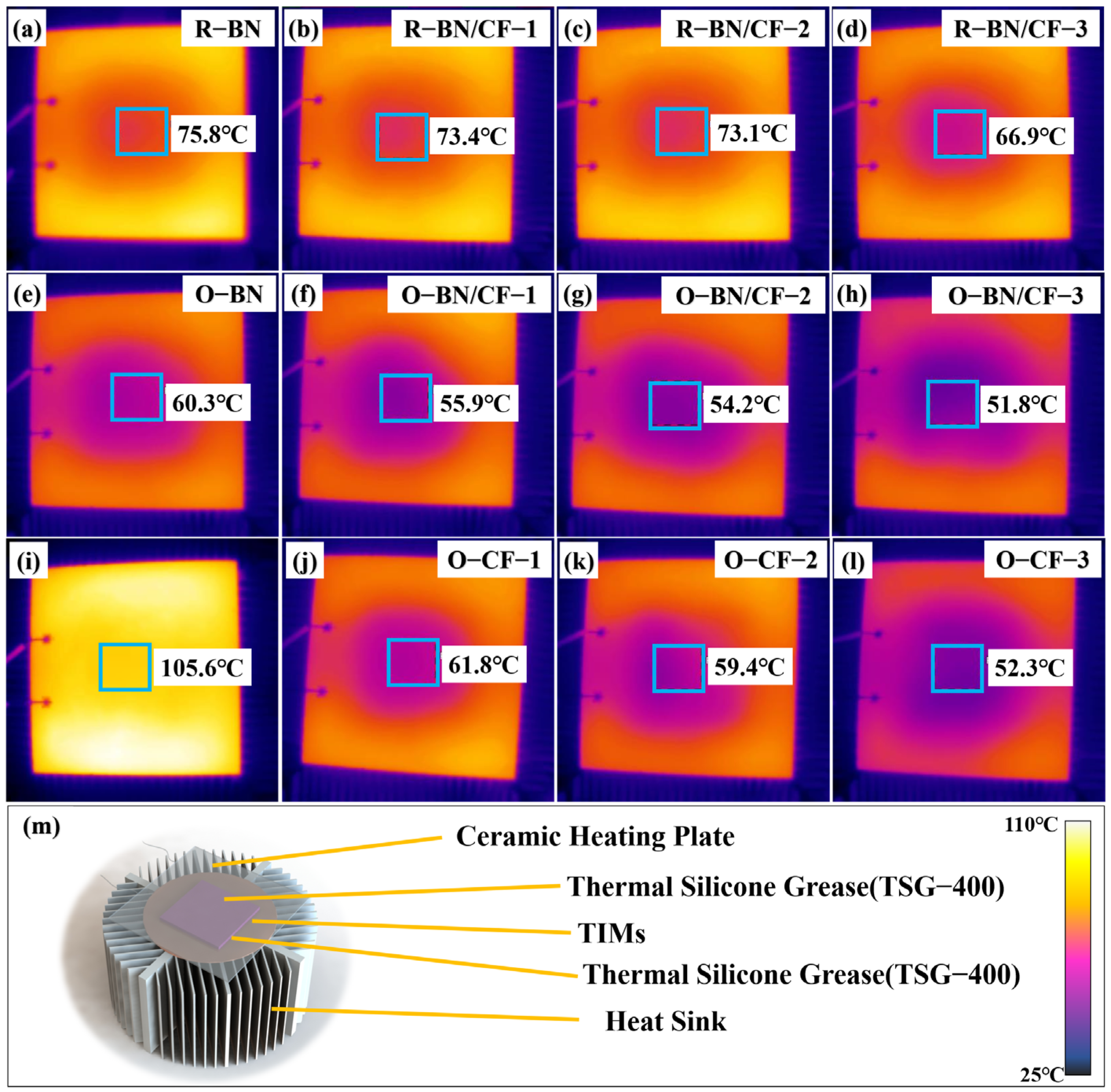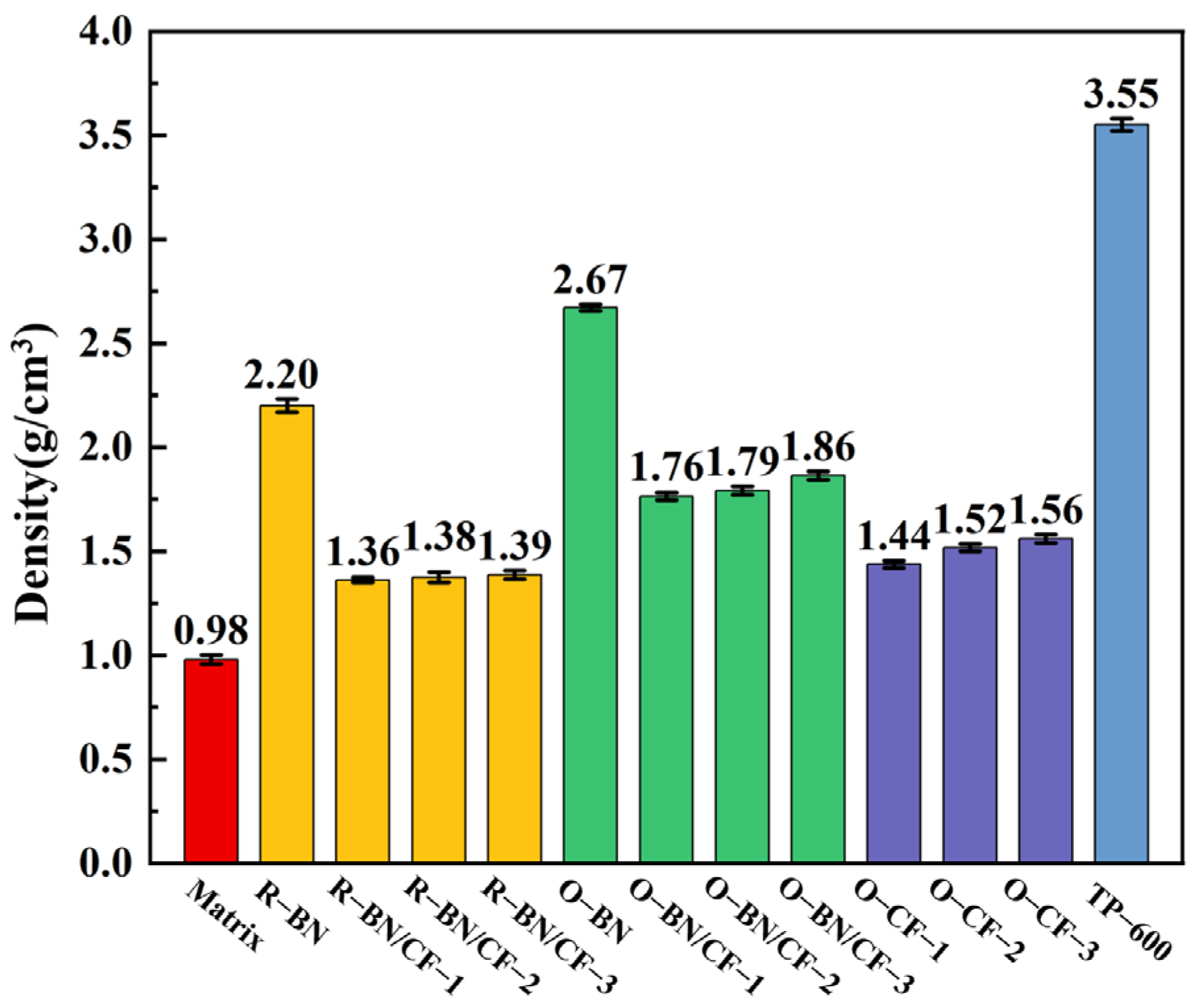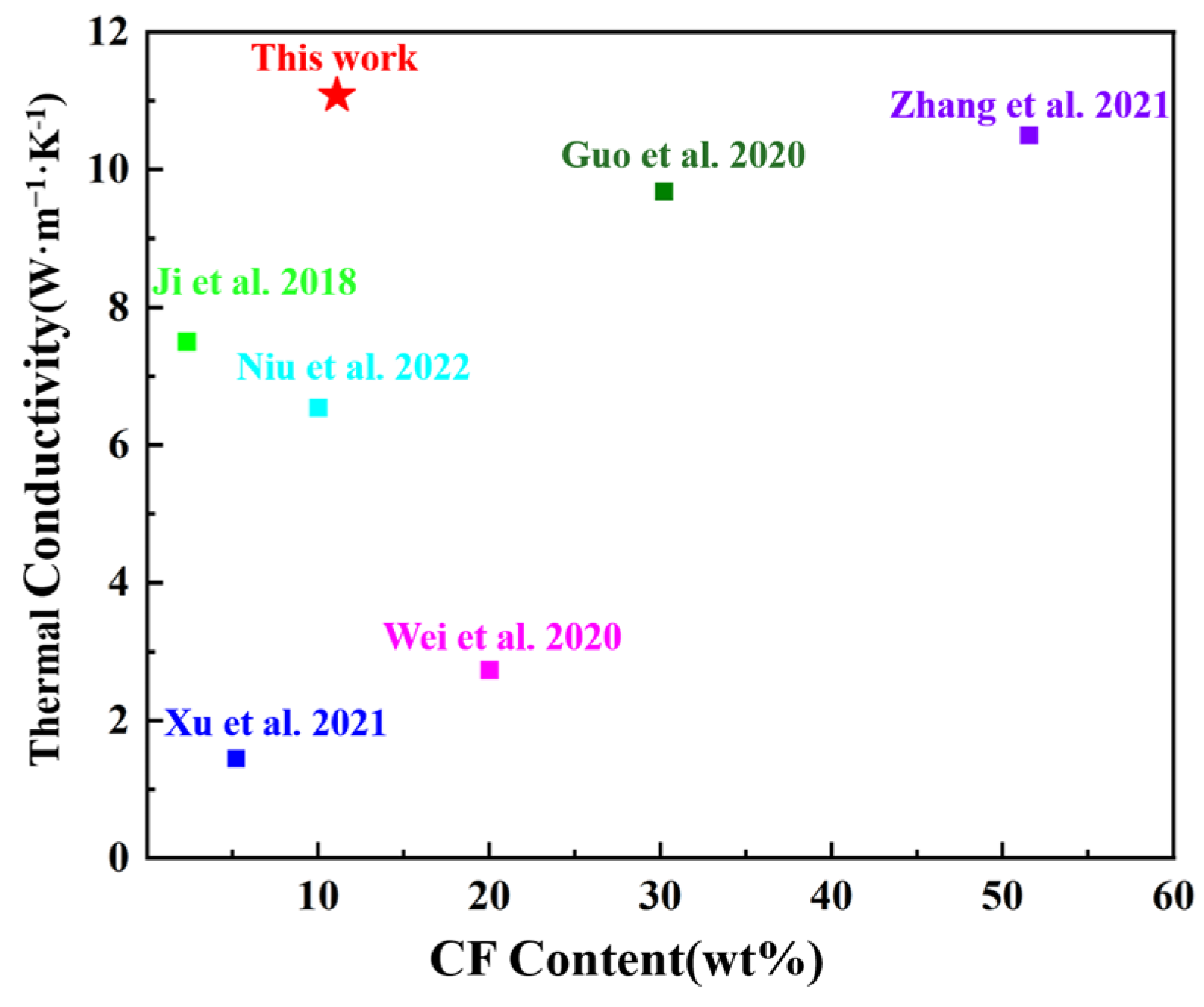Boron Nitride/Carbon Fiber High-Oriented Thermal Conductivity Material with Leaves–Branches Structure
Abstract
:1. Introduction
2. Materials and Methods
2.1. Materials
2.2. Preparation of Silicone Rubber Matrix and Random Composite Silicone Rubber
2.3. Preparation of Oriented Composite Silicone Rubber
2.4. Preparation of Binder
2.5. Test and Characterization
3. Results and Discussion
3.1. Thermal Conductivity of Composites
3.2. Structural Characterization of Composites
3.3. Infrared Characterization of Composites
3.4. Density Characterization of Composites
4. Conclusions
Author Contributions
Funding
Institutional Review Board Statement
Informed Consent Statement
Data Availability Statement
Conflicts of Interest
References
- Ishibe, T.; Okuhata, R.; Kaneko, T.; Yoshiya, M.; Nakashima, S.; Ishida, A.; Nakamura, Y. Heat transport through propagon-phonon interaction in epitaxial amorphous-crystalline multilayers. Commun. Phys. 2021, 4, 7. [Google Scholar] [CrossRef]
- Ota, A.; Ohnishi, M.; Oshima, H.; Shiga, T.; Kodama, T.; Shiomi, J. Enhancing thermal boundary conductance of graphite-metal interface by triazine-based molecular bonding. ACS Appl. Mater. Interfaces 2019, 11, 37295–37301. [Google Scholar] [CrossRef] [PubMed]
- Cui, Y.; Li, M.; Hu, Y.J. Emerging interface materials for electronics thermal management: Experiments, modeling, and new opportunities. J. Mater. Chem. C 2020, 8, 10568–10586. [Google Scholar] [CrossRef]
- Mouane, O.; Sideras-Haddad, E.; Nkadimeng, E.; McKenzie, R.; Van Rensburg, R.; Sandrock, C.; Mellado, B.; Coville, N.J. Heat conduction enhancement of a thermal interface material for heat sink applications using carbon nanomaterials. IEEE Trans. Nanotechnol. 2022, 21, 352–359. [Google Scholar] [CrossRef]
- Kim, S.K.; Koo, Y.J.; Kim, H.S.; Lee, J.K.; Jeong, K.; Lee, Y.; Jung, E.Y. Fabrication and characterization of AI2O3-siloxane composite thermal pads for thermal interface materials. Materials 2024, 17, 914. [Google Scholar] [CrossRef] [PubMed]
- Sitta, A.; Mauromicale, G.; Malgioglio, G.L.; Amoroso, D.M.; Schifano, B.; Calabretta, M.; Sequenzia, G. TIMs for transfer molded power modules: Characterization, reliability, and modeling. Microelectron. Reliab. 2023, 148, 7. [Google Scholar] [CrossRef]
- Mishra, P.; Paul, M.; Vinod, P.; Sarathi, R.; Kornhuber, S. Performance evaluation of room temperature vulcanized silicone rubber nanocomposites aged in strong aqueous solutions. Polym. Eng. Sci. 2022, 62, 1619–1630. [Google Scholar] [CrossRef]
- Vangapandu, D.N.; Paul, M.; Mishra, P.; Sarathi, R.; Kornhuber, S.; Thapliyal, S. Performance evaluation of thermally aged ATH and BN co-doped silicone rubber nano-micro composites for power cable applications. Polym. Eng. Sci. 2022, 62, 3868–3879. [Google Scholar] [CrossRef]
- Ahamad, A.; Pandey, K.N.; Mishra, S.; Sahu, A.K.; Vijayvargiy, R.; Rai, J.S.P. Comparative study on mechanical, thermal, and morphological properties of nanocomposites based on polyetherimide (PEI)/silicone rubber reinforced with different nanofillers. Polym. Bull. 2023, 80, 13117–13128. [Google Scholar] [CrossRef]
- Bashir, A.; Niu, H.Y.; Maqbool, M.; Usman, A.; Lv, R.C.; Ashraf, Z.; Cheng, M.; Bai, S.L. A novel thermal interface material composed of vertically aligned boron nitride and graphite films for ultrahigh through-plane thermal conductivity. Small Methods 2024, 14, e2301788. [Google Scholar] [CrossRef] [PubMed]
- Kong, N.Z.; Tian, Y.X.; Huang, M.; Ye, C.; Yan, Y.W.; Peng, C.Y.; Liu, J.S.; Han, F. Conformal BN coating to enhance the electrical insulation and thermal conductivity of spherical graphite fillers for electronic encapsulation field. J. Alloys Compd. 2023, 968, 10. [Google Scholar] [CrossRef]
- Jang, J.U.; Nam, H.E.; So, S.O.; Lee, H.; Kim, G.S.; Kim, S.Y.; Kim, S.H. Thermal percolation behavior in thermal conductivity of polymer nanocomposite with lateral size of graphene nanoplatelet. Polymers 2022, 14, 323. [Google Scholar] [CrossRef] [PubMed]
- Jang, S.; Choi, E.J.; Cheon, H.J.; Choi, W.I.; Shin, W.S.; Lim, J.M. Fabrication of Al2O3/ZnO and Al2O3/Cu reinforced silicone rubber composite pads for thermal interface materials. Polymers 2021, 13, 3259. [Google Scholar] [CrossRef] [PubMed]
- Liu, Y.; Li, J. A protocol to further improve the thermal conductivity of silicone-matrix thermal interface material with nano-fillers. Thermochim. Acta 2022, 708, 12. [Google Scholar] [CrossRef]
- Kumar, V.; Kumar, A.; Alam, M.N.; Park, S.S. Effect of graphite nanoplatelets surface area on mechanical properties of room-temperature vulcanized silicone rubber nanocomposites. J. Appl. Polym. Sci. 2022, 139, 12. [Google Scholar] [CrossRef]
- Fakiridis, S.; Hodge, S.A.; Karagiannidis, P.G. Thermal interface materials with hexagonal boron nitride and graphene fillers in pdms matrix: Thermal and mechanical properties. Energies 2023, 16, 2522. [Google Scholar] [CrossRef]
- Huang, F.; Qin, W.B.; Shu, D.F.; Sun, J.C.; Li, J.S.; Meng, D.Z.; Yue, W.; Wang, C.B. Steppingstone-inspired construction of high vertical thermal conductivity material with low carbon fiber content. Ceram. Int. 2023, 49, 32971–32978. [Google Scholar] [CrossRef]
- Niu, H.Y.; Guo, H.C.; Kang, L.; Ren, L.C.; Lv, R.C.; Bai, S.L. Vertical alignment of anisotropic fillers assisted by expansion flow in polymer composites. Nano-Micro Lett. 2022, 14, 15. [Google Scholar] [CrossRef] [PubMed]
- Cho, H.B.; Nakayama, T.; Suematsu, H.; Suzuki, T.; Jiang, W.H.; Niihara, K.; Song, E.; Eom, N.S.A.; Kim, S.; Choa, Y.H. Insulating polymer nanocomposites with high-thermal-conduction routes via linear densely packed boron nitride nanosheets. Compos. Sci. Technol. 2016, 129, 205–213. [Google Scholar] [CrossRef]
- Li, X.X.; Xu, Q.C.; Lei, Z.M.; Chen, Z.X. Electrostatic flocking assisted aligned boron nitride platelets scaffold for enhancing the through-plane thermal conductivity of flexible thermal interface materials. Ceram. Int. 2023, 49, 22623–22629. [Google Scholar] [CrossRef]
- Chung, S.H.; Kim, H.; Jeong, S.W. Improved thermal conductivity of carbon-based thermal interface materials by high-magnetic-field alignment. Carbon 2018, 140, 24–29. [Google Scholar] [CrossRef]
- Yuan, J.; Qian, X.T.; Meng, Z.C.; Yang, B.; Liu, Z.Q. Highly thermally conducting polymer-based films with magnetic field-assisted vertically aligned hexagonal boron nitride for flexible electronic encapsulation. ACS Appl. Mater. Interfaces 2019, 11, 17915–17924. [Google Scholar] [CrossRef] [PubMed]
- Mai, V.D.; Lee, D.I.; Park, J.H.; Lee, D.S. Rheological properties and thermal conductivity of epoxy resins filled with a mixture of alumina and boron nitride. Polymers 2019, 11, 597. [Google Scholar] [CrossRef] [PubMed]
- Murshed, S.M.S.; de Castro, C.A.N. A critical review of traditional and emerging techniques and fluids for electronics cooling. Renew. Sustain. Energy Rev. 2017, 78, 821–833. [Google Scholar] [CrossRef]
- Guo, L.C.; Zhang, Z.Y.; Li, M.H.; Kang, R.Y.; Chen, Y.P.; Song, G.C.; Han, S.T.; Lin, C.T.; Jiang, N.; Yu, J.H. Extremely high thermal conductivity of carbon fiber/epoxy with synergistic effect of MXenes by freeze-drying. Compos. Commun. 2020, 19, 134–141. [Google Scholar] [CrossRef]
- Ji, T.X.; Feng, Y.Y.; Qin, M.M.; Li, S.W.; Zhang, F.; Lv, F.; Feng, W. Thermal conductive and flexible silastic composite based on a hierarchical framework of aligned carbon fibers-carbon nanotubes. Carbon 2018, 131, 149–159. [Google Scholar] [CrossRef]
- Wei, J.M.; Liao, M.Z.; Ma, A.J.; Chen, Y.P.; Duan, Z.H.; Hou, X.; Li, M.H.; Jiang, N.; Yu, J.H. Enhanced thermal conductivity of polydimethylsiloxane composites with carbon fiber. Compos. Commun. 2020, 17, 141–146. [Google Scholar] [CrossRef]
- Xu, T.L.; Zhou, S.S.; Jiang, F.; Song, N.; Shi, L.Y.; Ding, P. Polyamide composites with improved thermal conductivity for effective thermal management: The three-dimensional vertically aligned carbon network. Compos. Part B Eng. 2021, 224, 10. [Google Scholar] [CrossRef]
- Zhang, X.F.; Zhou, S.L.; Xie, B.; Lan, W.; Fan, Y.W.; Hu, R.; Luo, X.B. Thermal interface materials with sufficiently vertically aligned and interconnected nickel-coated carbon fibers under high filling loads made via preset-magnetic-field method. Compos. Sci. Technol. 2021, 213, 9. [Google Scholar] [CrossRef]







| Experimental Group | Mass of Component (g) | Content of CF | |||
|---|---|---|---|---|---|
| SIR | BN | CF | Alumina | ||
| Matrix | 12 | / | / | / | 0 |
| Random-BN | 12 | 12 | / | / | 0 |
| Oriented-BN | 12 | 12 | / | / | 0 |
| Random-BN/CF-1 | 12 | 12 | 1 | / | 4 |
| Oriented-BN/CF-1 | 12 | 12 | 1 | / | 4 |
| Random-BN/CF-2 | 12 | 12 | 2 | / | 7.8 |
| Oriented-BN/CF-2 | 12 | 12 | 2 | / | 7.8 |
| Random-BN/CF-3 | 12 | 12 | 3 | / | 11.1 |
| Oriented-BN/CF-3 | 12 | 12 | 3 | / | 11.1 |
| Oriented-CF-1 | 12 | / | 1 | / | 7.7 |
| Oriented-CF-2 | 12 | / | 2 | / | 14.3 |
| Oriented-CF-3 | 12 | / | 3 | / | 20.0 |
| Binder | 12 | / | / | 80 | 0 |
Disclaimer/Publisher’s Note: The statements, opinions and data contained in all publications are solely those of the individual author(s) and contributor(s) and not of MDPI and/or the editor(s). MDPI and/or the editor(s) disclaim responsibility for any injury to people or property resulting from any ideas, methods, instructions or products referred to in the content. |
© 2024 by the authors. Licensee MDPI, Basel, Switzerland. This article is an open access article distributed under the terms and conditions of the Creative Commons Attribution (CC BY) license (https://creativecommons.org/licenses/by/4.0/).
Share and Cite
Shu, D.; Sun, J.; Huang, F.; Qin, W.; Wang, C.; Yue, W. Boron Nitride/Carbon Fiber High-Oriented Thermal Conductivity Material with Leaves–Branches Structure. Materials 2024, 17, 2183. https://doi.org/10.3390/ma17102183
Shu D, Sun J, Huang F, Qin W, Wang C, Yue W. Boron Nitride/Carbon Fiber High-Oriented Thermal Conductivity Material with Leaves–Branches Structure. Materials. 2024; 17(10):2183. https://doi.org/10.3390/ma17102183
Chicago/Turabian StyleShu, Dengfeng, Jiachen Sun, Fei Huang, Wenbo Qin, Chengbiao Wang, and Wen Yue. 2024. "Boron Nitride/Carbon Fiber High-Oriented Thermal Conductivity Material with Leaves–Branches Structure" Materials 17, no. 10: 2183. https://doi.org/10.3390/ma17102183






